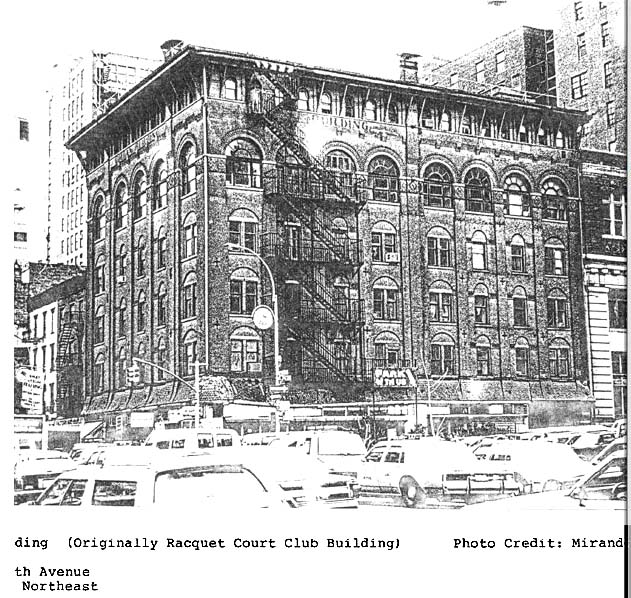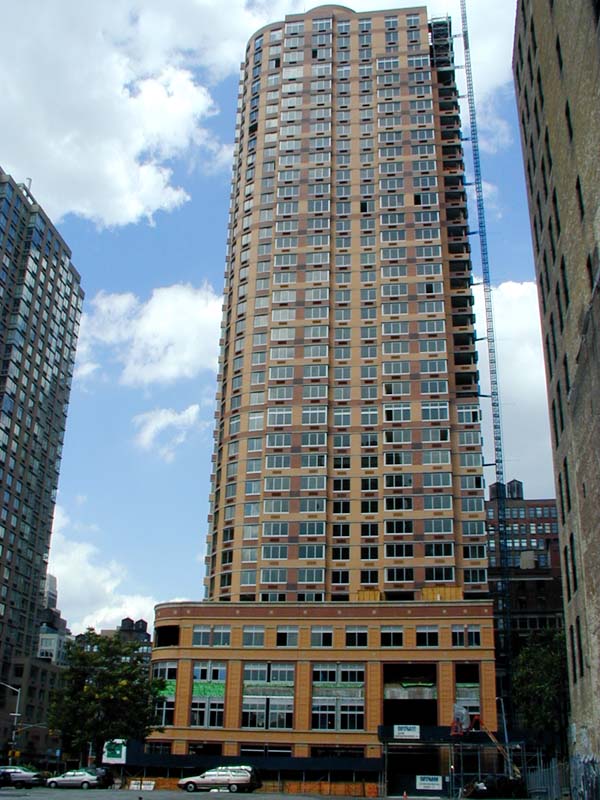| New York
Architecture Images-Gone Coogan Building formerly the Racquet Club Building |
|
|
architect |
A.H. Thorpe |
|
location |
776 Sixth Ave. at 26th St. |
|
date |
1875-76 |
|
style |
|
|
construction |
6 stories, constructed of brick, with arched windows |
|
type |
Club |
|
|
I originally had the Coogan Building on my list of important NY buildings to photograph. I turned up at the site in 2001 to find the new residential high-rise. Strange, I thoght, that such a bland building could be thought of as important. |
|
images |
 |
|
|
 |
|
notes |
Originally the
Racket Court Club which was landmarked and then de-landmarked by Mayor David
Dinkins -- unique arhcitectural details that appear on no other building in
New York City.
by Leonard Jacobs The Landmark Loophole: How Protected Structures Can Still Face Demolition (March '01) The New York City Landmarks Preservation Commission, created by Mayor Robert F. Wagner in 1965 following the demolition of the old Pennsylvania Station, has been widely acclaimed as a pioneer in preservation work. Nearly every Broadway theater, for instance, has been granted landmark status, whether for the exterior of the theatre, the interior, or (frequently) both. The work of the 11-member Commission mainly involves the regulation and protection of over 20,000 buildings (some interior, some exterior, some both), plus various "historic districts" and "scenic landmarks" in each of the five boroughs. Under a broad statute in which a tree may even be designated a "landmark," how exactly do you define a landmark? According to Barbaralee Diamonstein's book, "The Landmarks of New York," a landmark is "a structure at least thirty years old . . . that has a special character or special historical or aesthetic interest or value as part of the development, heritage or cultural characteristics of the city, state or nation." In recent years, under the leadership of Commissioner Jennifer J. Raab, a Giuliani appointee (who is leaving to become the president of Hunter College), the Commission has also developed a reputation as the benevolent referee between preservationists and property owners and developers, their eyes all keenly attuned to the economy. To be sure, New York City's "landmark law" is a largely rigorous and pro-preservationist one; every mayor since Wagner, including Mayor Giuliani, has supported the Commission's work. Whether reviewing applications to alter landmarked structures (subject to public review) or reviewing the thousands of new requests for designation, the work of the Commission has much good will from city planners, businesspeople, and historians alike. That a structure granted "landmark status" is protected from wanton destruction is well-known. What is not well-known, however -- and what the Commission would prefer to keep little-known -- is the fact that some circumstances do legally allow a so-called protected structure to be demolished. All an owner need do is prove that the landmark is an economic hardship for him. Under such circumstances, most landmarks are vulnerable. It was in 1982, the year Wall Street's bull market first began fueling a remarkable period of development, that three historic Broadway theaters -- the Helen Hayes, the Bijou, and the Morosco -- were demolished to make room for the Marriott Marquis Hotel. A coalition of artists and politicians quickly formed, seeking a mass "landmarking of Broadway" that would protect the remaining theaters into perpetuity. Broadway theater owners adamantly opposed the move at the time, fearing they would be unable to continue profiting from these structures, but the Commission did designate most of them as landmarks. No one then could have foreseen the dramatic economic revival of Times Square. The boom was helped along by changes in the zoning resolution to allow theater owners to sell the "development rights" above low-rise theaters. It is a long-shot, but it is possible that one day, Broadway's three main theatre owners -- the Shubert Organization, the Nederlander Organization, and the Jujamcyn Organization -- may plead economic hardship in order to raze Broadway playhouses once again. Obtaining permission to demolish a landmark is a long and torturous process, but it can happen under several circumstances. Demolition is meant to be a last resort, especially in cases of economic hardship. First there must be an official finding of hardship; nobody is going to take the owner's word for it. "The burden of proof is on the owner," says Alex Herrera, director of technical services for the New York Landmarks Conservancy, which provides grants, low-interest loans, hands-on consulting services, workshops, and publications in order to help owners of historic properties preserve what they have. Then, if the Landmarks Preservation Commission determines that an owner cannot earn a reasonable return on their investment (currently six percent), the Commission can seek tax breaks for the owner, or even obtain an "appropriate protective interest," a euphemism for a new owner. The Commission has a limited amount of time to remedy the situation,. It is only after every available alternative has been exhausted that the Commission may allow the property owner to demolish the structure. "It's a testimonial that New York is in such good condition and that landmarks are really a very positive thing that the provision has hardly been used," Herrera says. But it has been used. The owners of the Coogan Building, a former racquet club at West 26th Street and the Avenue of the Americas, of a group of row houses on Central Park West, and of the former Mt. Neboh Temple, all claimed economic hardship. The Commission explored all alternatives, to no avail. All these landmarks have been demolished. The Mt. Neboh case is of particular interest to preservationists and developers alike. "When you are dealing with a religious institution," Herrera says, "there's a much more fungible definition of what hardship is." Some congregations, for instance, have determined that their house of worship is "no longer suitable for its intended purpose," so instead of a six percent rule determining economic hardship, the demolishing of a religious property may be requested in order to accommodate the needs of the congregation. This does not mean that houses of worship have free reign. In 1984, St. Bartholomew's Church, on Park Avenue and East 50th Street, proposed to demolish its landmarked Community House and replace it with an office tower, the first few floors of which would provide the Church with much-needed space. The Landmarks Preservation Commission denied the request. Subsequent appeals went all the way to the Supreme Court, which ruled in favor of the Commission. The Court cited, however, the "safety valve" embedded in the law - the right of owners to demolish their landmarks under certain circumstances. Of course, there are other ways to destroy houses of worship and Broadway theaters besides demolishing them. The Nederlander Organization closed the Mark Hellinger Theater, a landmark, by selling to a religious organization, which made it into the Times Square Church. The end of this theater - and the beginning of this church - needed approval by the City Planning Commission. But since the sale did not materially affect the physical structure, the Landmarks Preservation Commission had nothing to say about this theatrical "demolition" (or spiritual "development.") |